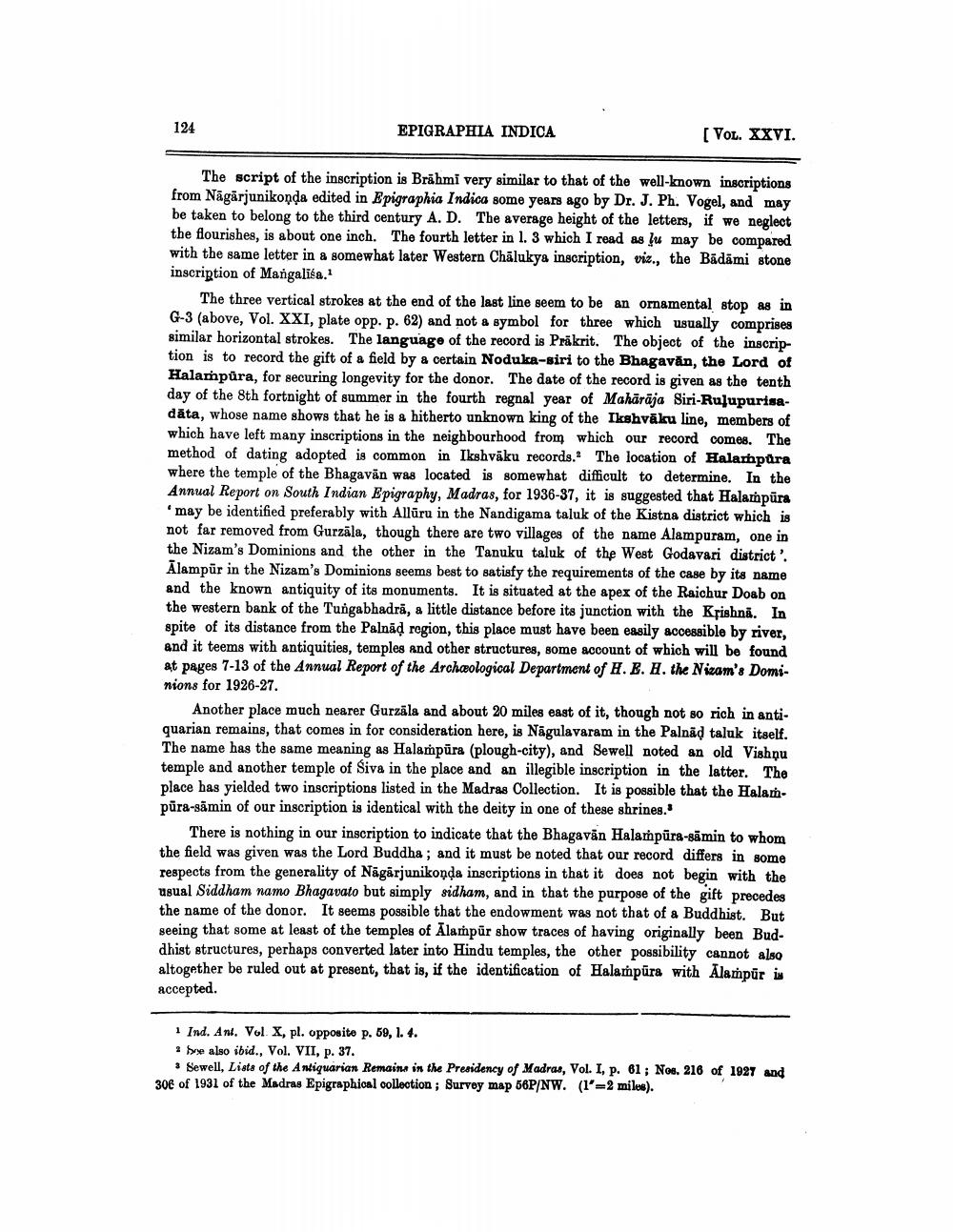________________
124
EPIGRAPHIA INDICA
[Vol. XXVI.
The script of the inscription is Brahmi very similar to that of the well-known inscriptions from Nāgārjunikonda edited in Epigraphia Indica some years ago by Dr. J. Ph. Vogel, and may be taken to belong to the third century A. D. The average height of the letters, if we neglect the flourishes, is about one inch. The fourth letter in l. 3 which I read as ļu may be compared with the same letter in a somewhat later Western Chalukya inscription, viz., the Bädāmi stone inscription of Mangaliba.
The three vertical strokes at the end of the last line seem to be an ornamental stop as in G-3 (above, Vol. XXI, plate opp. p. 62) and not a symbol for three which usually comprises similar horizontal strokes. The language of the record is Prakrit. The object of the inscription is to record the gift of a field by a certain Noduka-siri to the Bhagavān, the Lord of Halampura, for securing longevity for the donor. The date of the record is given as the tenth day of the 8th fortnight of summer in the fourth regnal year of Mahārāja Siri-Rulupurisadata, whose name shows that he is a hitherto unknown king of the Ikshvāku line, members of which have left many inscriptions in the neighbourhood from which our record comes. The method of dating adopted is common in Ikshvāku records. The location of Halampura where the temple of the Bhagavān was located is somewhat difficult to determine. In the Annual Report on South Indian Epigraphy, Madras, for 1936-37, it is suggested that Halampūra
may be identified preferably with Allüru in the Nandigama taluk of the Kistna district which is not far removed from Gurzala, though there are two villages of the name Alampuram, one in the Nizam's Dominions and the other in the Tanuku taluk of the West Godavari district'. Alampur in the Nizam's Dominions seems best to satisfy the requirements of the case by its name and the known antiquity of its monuments. It is situated at the apex of the Raichur Doab on the western bank of the Tungabhadrā, a little distance before its junction with the Krishna. In spite of its distance from the Palnād region, this place must have been easily accessible by river, and it teems with antiquities, temples and other structures, some account of which will be found at pages 7-13 of the Annual Report of the Archeological Department of H. B. H. the Nizam's Dominions for 1926-27.
Another place much nearer Gurzäla and about 20 miles east of it, though not so rich in antiquarian remains, that comes in for consideration here, is Nägulavaram in the Palnãd taluk itself. The name has the same meaning as Halampūra (plough-city), and Sewell noted an old Vishnu temple and another temple of Siva in the place and an illegible inscription in the latter. The place has yielded two inscriptions listed in the Madras Collection. It is possible that the Halampūra-sāmin of our inscription is identical with the deity in one of these shrines.'
There is nothing in our inscription to indicate that the Bhagavan Halampūra-sāmin to whom the field was given was the Lord Buddha, and it must be noted that our record differs in some respects from the generality of Nagarjunikonda inscriptions in that it does not begin with the usual Siddham namo Bhagavato but simply sidham, and in that the purpose of the gift precedes the name of the donor. It seems possible that the endowment was not that of a Buddhist. But seeing that some at least of the temples of Alampur show traces of having originally been Buddhist structures, perhaps converted later into Hindu temples, the other possibility cannot also altogether be ruled out at present, that is, if the identification of Halampūra with Alampur is accepted.
1 Ind. Ant. Vol. X, pl. opposite p. 59, 1. 4. i bre also ibid., Vol. VII, p. 37.
• Sewell. Lists of the Antiquarian Remains in the Presidency of Madras, Vol. I, p. 61; Nos. 216 of 1927 and 30€ of 1931 of the Madras Epigraphical collection ; Survey map 56P/NW. (l'=2 miles).




